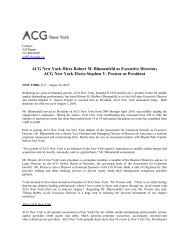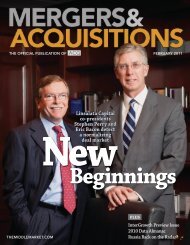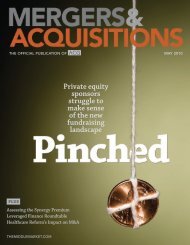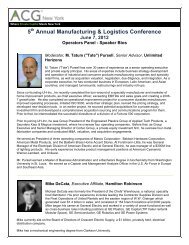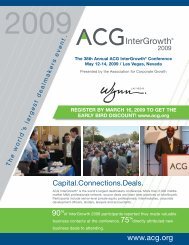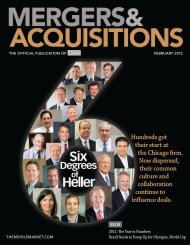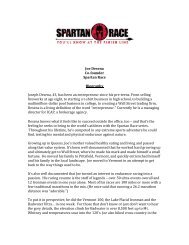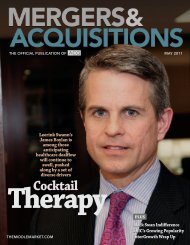Not one to mince words, KPS Capital's Michael Psaros offers a ...
Not one to mince words, KPS Capital's Michael Psaros offers a ...
Not one to mince words, KPS Capital's Michael Psaros offers a ...
- No tags were found...
You also want an ePaper? Increase the reach of your titles
YUMPU automatically turns print PDFs into web optimized ePapers that Google loves.
20-35_Roundup.qxd 4/6/09 5:39 PM Page 86FRAUD continued from page 22A background check of the key people can also shed light. Spinellimentions <strong>one</strong> deal involving a bank, in which the principals involvedappeared “cleaner than Caesar’s wife.” A deeper investigation revealedtwo convicted felons.It’s often the case that the schemes are specific <strong>to</strong> a particular industry.In publishing, for instance, there was the public battle involvingAbry Partners and Providence Equity Partners. Abry claimed thatProvidence portfolio company F&W Publications used channel-stuffingthrough volume discounts ahead of the sale, which propped upthe order count, at least until the vendors started sending orders back.In retail, Steve & Barry’s is being sued for using tenant-improvementpayments <strong>to</strong> overstate its equity and assets. The company was sold lastJuly <strong>to</strong> a pair of hedge funds and ended up moving forward with aliquidation plan just a few months later.The most creative instances of fraud, according <strong>to</strong> Bahl, is alwayscollusion “involving more than <strong>one</strong> company.” Bahl cites as an examplethe manufacturing sec<strong>to</strong>r. “In these cases you need <strong>to</strong> look at thebusiness partners and look all the way down the supply chain,” he says.“It forces you <strong>to</strong> analyze multiple sets of transactions rather than just<strong>one</strong> person’s financials.”So how can dealmakers root out corruption? According <strong>to</strong> Spinelli,the key is <strong>to</strong> look for it. “It amazes me how little due diligence is beingd<strong>one</strong>,” he says, specifying that scrutiny should include financialand investigative due diligence as well as a very hard look at the complianceprocedures of an organization.“The vast majority of fraud is not a <strong>one</strong>-off scam,” he adds. “Thepeople who do it once, will do it again, and they’ll do it just a little bitat a time so they won’t get caught.”MEZZ continued from page 34second lien market crumbled and BDCs began showing weakness, themezz market held strong. During the first two quarters of 2008, forinstance, the percentage of mezzanine financing going in<strong>to</strong> dealsgrew substantially over 2007, roughly doubling its average allocationwithin the capital structure. Meanwhile, the BDCs, CLOs andhedge funds are effectively shut out from the lending market.“Prior <strong>to</strong> the chaos that started in September 2008, the mezzmarket was getting stronger, and it was starting <strong>to</strong> shine. We werebusy,” says <strong>Michael</strong> Klofas, a managing direc<strong>to</strong>r with Babson CapitalManagement. “But since Oc<strong>to</strong>ber, we are not seeing a lot of dealactivity in general and mezz deals, in particular, have been few andfar between.”Indeed, prior <strong>to</strong> September 2008, Tower Square III had alreadycompleted 13 transactions and deployed 11% of its capital undermanagement. Since then the fund has only completed <strong>one</strong> transactionwith three in the pipeline.The bot<strong>to</strong>m line is that senior lenders need <strong>to</strong> start lending againbefore mezz players can make any kind of headway.“Regular people can’t even get mortgages, how is a leverage buyoutsupposed <strong>to</strong> be completed?” asks <strong>one</strong> lender. “We need the entirelending market <strong>to</strong> start running well again, but who knows exactlywhen that will be.”While few will even guess as <strong>to</strong> when the credit markets willloosen up, commercial banks weren’t created for long term CDs.Eventually, when the remaining banks regain their appetite for risk,the mezzanine market will be positi<strong>one</strong>d <strong>to</strong> benefit.“There’s a lot of private equity m<strong>one</strong>y on the sidelines. Senior lendingwill come back, purchase price multiples will come down andmezz will do better,” says Steuerman.For now, however, it’s just a renaissance delayed.BACK TO THE WELL continued from page 33 ADD-ONS continued from page 32activity on the part of private equity firms could be “especially pronounced”when the inves<strong>to</strong>rs still hold an interest in the assets, eitherthrough earnout provisions or minority stakes.And even if the old targets present new challenges for the inves<strong>to</strong>rs,Wilson notes that those are the types of deals that privateequity buyers find most tempting. “The ideal acquisition for the privateequity buyer is something slightly damaged that they understand;those are the deals that they can arbitrage and enhance, whichis where they can add value.”ensuing integration can test the mettle of even the best opera<strong>to</strong>rs.As Welsh Carson Anderson & S<strong>to</strong>we general partner John Almeidastated in a Mergers & Acquisitions roundtable last year: “If youdon’t know how <strong>to</strong> operate businesses, you can’t do these deals becausethat’s the quickest way <strong>to</strong> screw up a situation, period.”With that said, whether a firm can be considered an operations-orientedgroup or not, if add-ons are the only game <strong>to</strong>wnfor dealmaking, it’s expected that most inves<strong>to</strong>rs will explore theopportunity.VAPORS continued from page 48over the past two years, if they added <strong>to</strong> the buyer’s debt load, mayeven spark more M&A as these companies look <strong>to</strong> shuttle assets <strong>to</strong>pay down debt or rearrange the portfolio. For buyers in the midmarketspace, this will present an opportunity.Ashland, for example, recently flagged a number of assets considerednoncore, which could fetch between $40 million and $400 millionapiece. The company sold its FiberVisions unit <strong>to</strong> private equityfirm Snow Phipps Group, realizing $7 million in proceeds. SnowPhipps also assumed $90 million in debt, and the sale will create asubstantial tax loss for Ashland.Similar deals could be in the offing as more companies hit theproverbial wall. One dealmaker, who preferred anonymity, says ofLyondell and Ineos: “They are trying <strong>to</strong> figure out how <strong>to</strong> surviveright now, and their banks are getting very nervous... we will likelysee asset sales whether or not they go bankrupt.”Leland Harrs, a managing direc<strong>to</strong>r at KeyBanc Capital Markets,notes that whether or not M&A is the solution, the status quo likelyisn’t. “More of the same doesn’t really help any<strong>one</strong>,” he says.86 MERGERS & ACQUISITIONS February 2009



